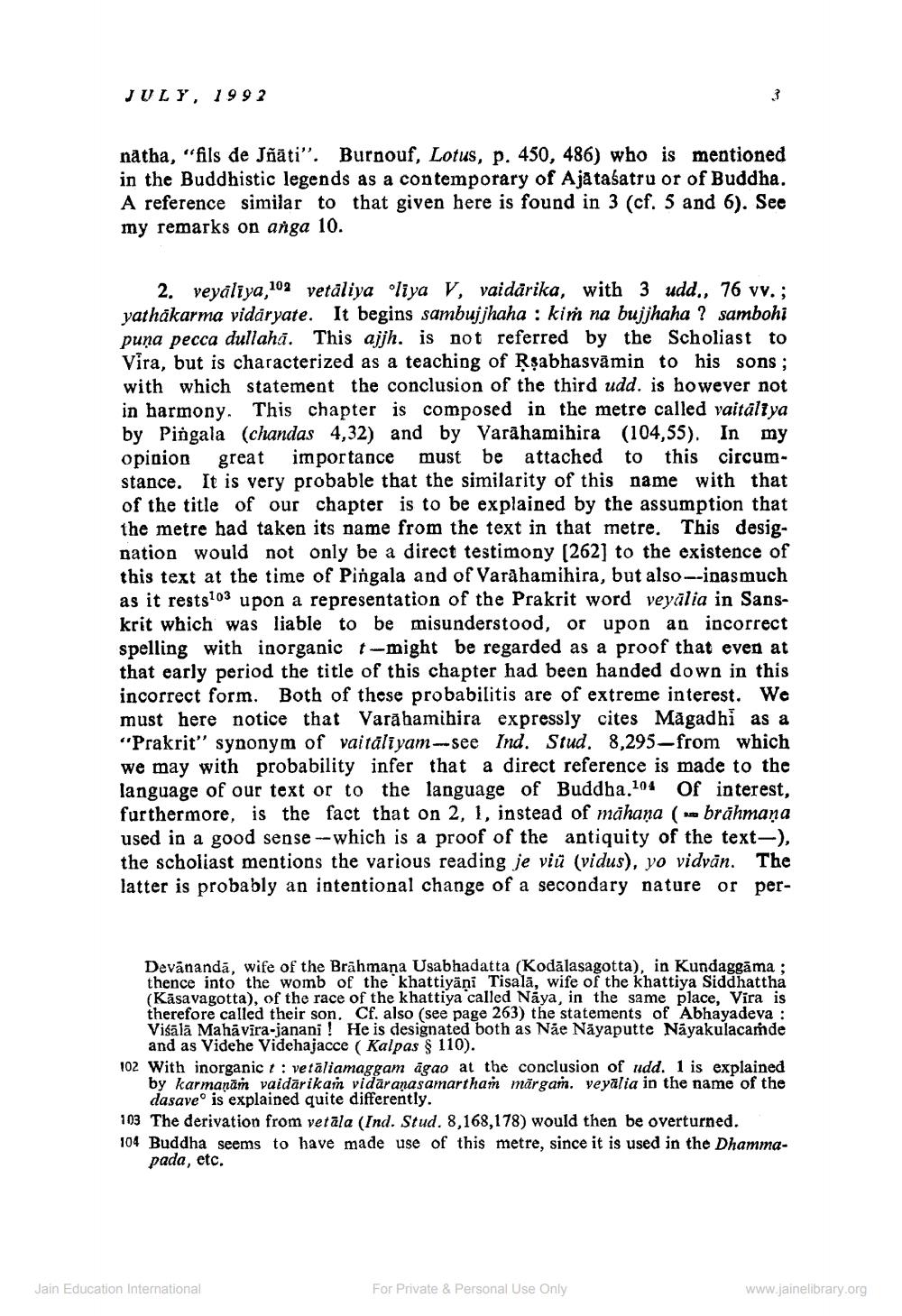Book Title: Jain Journal 1992 07 Author(s): Jain Bhawan Publication Publisher: Jain Bhawan Publication View full book textPage 8
________________ JULY, 1992 natha, "fils de Jñati". Burnouf, Lotus, p. 450, 486) who is mentioned in the Buddhistic legends as a contemporary of Ajataśatru or of Buddha. A reference similar to that given here is found in 3 (cf. 5 and 6). See my remarks on anga 10. 2. veyālīya,102 vetaliya liya V, vaidarika, with 3 udd., 76 vv.; yathakarma vidaryate. It begins sambujjhaha: kim na bujjhaha? sambohi puna pecca dullaha. This ajjh. is not referred by the Scholiast to Vira, but is characterized as a teaching of Rsabhasvamin to his sons; with which statement the conclusion of the third udd. is however not in harmony. This chapter is composed in the metre called vaitaliya by Pingala (chandas 4,32) and by Varahamihira (104,55). In my opinion great importance must be attached to this circumstance. It is very probable that the similarity of this name with that of the title of our chapter is to be explained by the assumption that the metre had taken its name from the text in that metre. This designation would not only be a direct testimony [262] to the existence of this text at the time of Pingala and of Varahamihira, but also--inasmuch as it rests103 upon a representation of the Prakrit word veyālia in Sanskrit which was liable to be misunderstood, or upon an incorrect spelling with inorganic t-might be regarded as a proof that even at that early period the title of this chapter had been handed down in this incorrect form. Both of these probabilitis are of extreme interest. We must here notice that Varāhamihira expressly cites Magadhi as a "Prakrit" synonym of vaitaliyam-see Ind. Stud. 8,295-from which we may with probability infer that a direct reference is made to the language of our text or to the language of Buddha.104 Of interest, furthermore, is the fact that on 2, 1, instead of mahana ( - brāhmaṇa used in a good sense-which is a proof of the antiquity of the text-), the scholiast mentions the various reading je viu (vidus), yo vidvän. The latter is probably an intentional change of a secondary nature or per Devanandā, wife of the Brahmana Usabhadatta (Kodālasagotta), in Kundaggāma; thence into the womb of the khattiyäni Tisala, wife of the khattiya Siddhattha (Kasavagotta), of the race of the khattiya called Naya, in the same place, Vira is therefore called their son. Cf. also (see page 263) the statements of Abhayadeva: Visala Mahavira-janani! He is designated both as Nãe Nayaputte Nayakulacaṁde and as Videhe Videhajacce (Kalpas § 110). 102 With inorganic t vetaliamaggam agao at the conclusion of udd. 1 is explained by karmanām vaidarikam vidaraṇasamartham margam. veyalia in the name of the dasave is explained quite differently. 103 The derivation from vetāla (Ind. Stud. 8,168,178) would then be overturned. 104 Buddha seems to have made use of this metre, since it is used in the Dhammapada, etc. Jain Education International For Private & Personal Use Only www.jainelibrary.orgPage Navigation
1 ... 6 7 8 9 10 11 12 13 14 15 16 17 18 19 20 21 22 23 24 25 26 27 28 29 30 31 32 33 34 35 36 37 38 39 40 41 42 43 44 45 46 47 48 49 50 51 52 53 54 55 56 57 58 59 60 61 62
